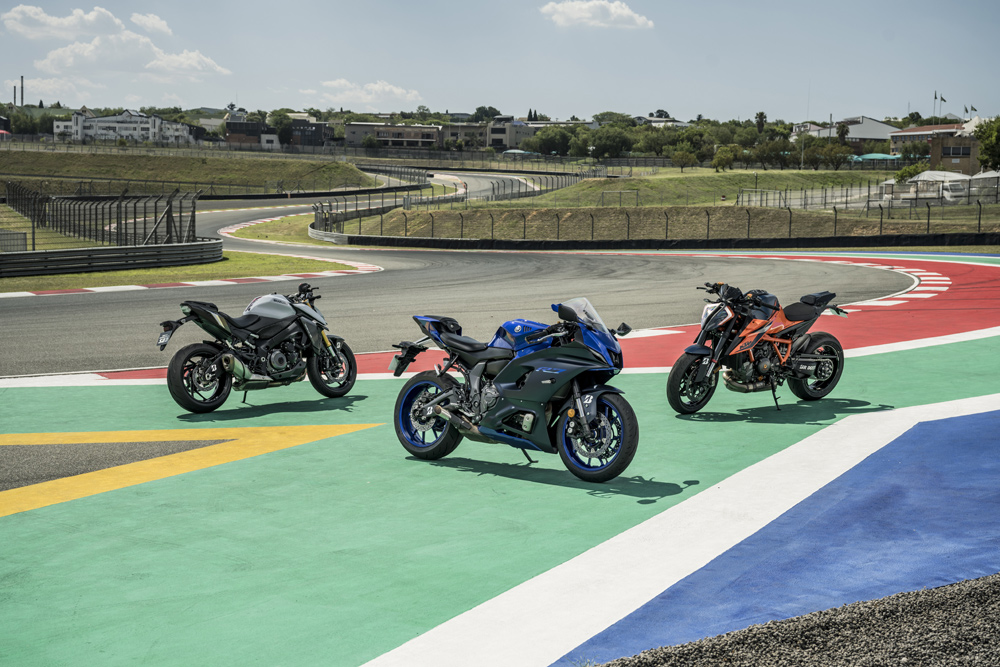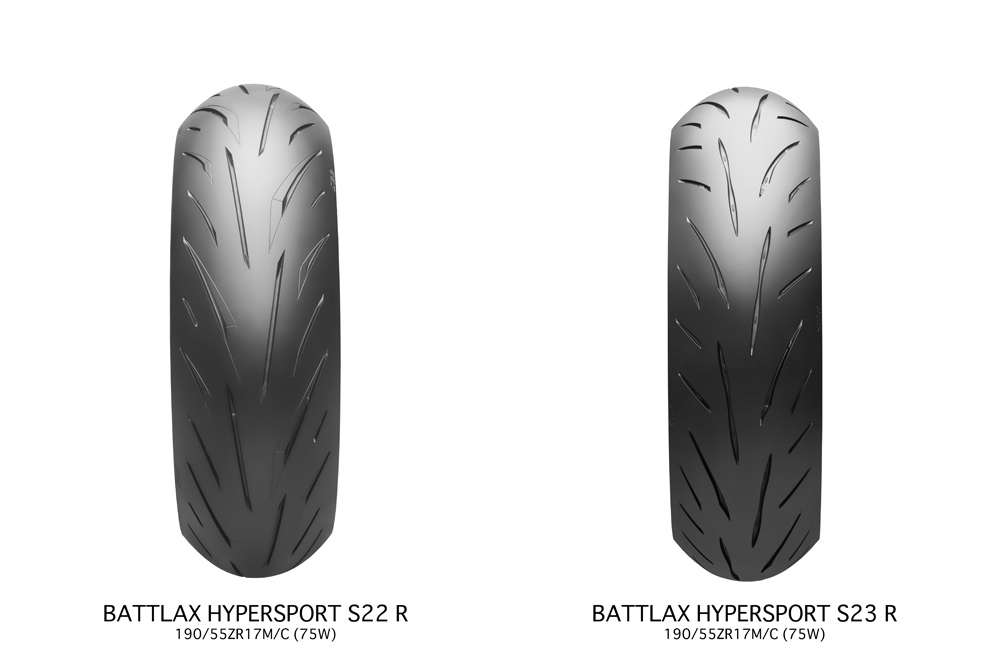Rennie Scaysbrook | December 23, 2023
Bridgestone seems to be one of those unsung heroes of the motorcycle industry here in America.
The company has traditionally lagged behind arch-rivals Dunlop and, to a lesser extent, Pirelli, in terms of U.S. exposure and market share despite categorically having some of the best tires in the world regardless of the riding segment.
This is something the Japanese giant aims to rectify in 2024 with the release of the Battlax S23 Hypersport tire, which slots ahead of the five-year-old S22 we tested at Jerez back in 2019.
 The S23 will fit bikes from Yamaha’s YZF-R7 through to bruisers like the KTM 1290 Super Duke R.
The S23 will fit bikes from Yamaha’s YZF-R7 through to bruisers like the KTM 1290 Super Duke R.
The S23 doesn’t replace the S22, which Bridgestone says still has a worthy place in its lineup, especially in Europe, but sits behind the premium RS11 hypersport street tire we first saw in 2020.
The rise in hypersport tires that can be used for everyday tasks is not surprising. The tires we’re seeing now that can be taken to the track, thrashed and not require tire warmers, stands, etc., while still being capable of doing a cold morning shop run in perfect safety are getting more numerous by the year.
The S23 comes to dealer floors in a very busy time with Dunlop’s Q5, Pirelli Diablo Rosso IV, Michelin Power 5, and Continental’s ContiSportAttack 2 all offering exceptional performance at competitive prices.
Improving on the S22 wasn’t going to be easy for Bridgestone as the S22 was such a great product, and a personal favorite for me, especially the feel of that front tire. KTM even went as far as putting it as OEM fitment for the previous-generation 1290 Super Duke in 2020, but have since swapped to Michelin Power Grip GP rubber for the 2024 1390 Super Duke.
In S23 guise, Bridgestone is claiming a five percent higher cornering speed, a one percent faster dry lap time, a three percent shorter wet braking distance, and a four percent faster wet lap time. Whether any of the lap time stuff really matters is up to you as this is a sports tire that can go to the track, not a race tire designed for ultimate lap times. However, the braking distances and cornering speeds should be something worth noting.
The S23 runs a new compound in both the front and rear using Bridgestone’s MS-Belt construction. Both ends are stiffer in the sidewalls than in S22 guise, allowing for more stability and increased grip at high lean angles, while a harder center compound in the rear allows for a claimed eight percent increase in mileage.
Its look is fairly different, too. The S23 front runs a new tread pattern with fewer longer center grooves, doing away with the more plentiful shorter center grooves of the S22, giving the S23 a superior Land-Sea ratio and allowing for greater water dispersion.
On the rear tire, Bridgestone is debuting what it calls Pulse Groove technology in the tread design, which concentrates the water into the center of the groove. In basic terms, it speeds up the water dispersion to get it out of the way and allow the part of the tire void of the grooves to do its job and stick to the road.
To test out the new S23, we headed to the fantastic Kyalami circuit just out of Johannesburg in South Africa. Bridgestone had about 60 riders in attendance, and each bike was only given one set of S23s, so each bike did well over 100 laps for a set of tires, and there was not a tire warmer in sight.
 The KTM 890 SMT is the near-perfect bike for the S23—plenty of power to have fun but not enough to stress the rear over many laps.
The KTM 890 SMT is the near-perfect bike for the S23—plenty of power to have fun but not enough to stress the rear over many laps.
Lowdown | Bridgestone Battlax S23 Hypersport Tire Review
Standout Feature: Increased cornering speed matched to excellent stability on the side of the front tire.
List Price: Starting at $249.49 for a 120/70 ZR17 front and $302.19 for a 180/55 ZR17 rear. Final prices are yet to be determined for the U.S. market.
 Competitively priced
Competitively priced
 Great front-end feel
Great front-end feel
 Last for miles and miles on track day
Last for miles and miles on track day
 We didn’t do any wet weather testing, so can’t verify Bridgestone’s claims
We didn’t do any wet weather testing, so can’t verify Bridgestone’s claims
Rider Analysis | Bridgestone Battlax S23 Hypersport Tire Review
 KTM’s 1290 Super Duke R will give an S23 a real thrashing, but the tire held up very well over the day with a myriad of different riders.
KTM’s 1290 Super Duke R will give an S23 a real thrashing, but the tire held up very well over the day with a myriad of different riders.
Testing street tires on the racetrack is always interesting. You don’t want to push too hard because you know there’s not going to be the final level of grip you’d expect from a racing tire. However, push too little, and you’re not going to experience the difference to the old tire.
Speaking of which, I loved the S22 when it came out in 2019. The turn-on moment for me was when chasing my colleague Adam Waheed around the iconic Jerez circuit in Spain and burying the front end so hard I was convinced I was going to crash, but still came out the other side unscathed. Pretty damn good for a street tire, I thought.
The second point where I realized they were such a good tire was on the 2020 1290 Super Duke R launch where I was in the last group and had to take the handlebars of a KTM that had done over 130 laps of the undulating Portimao circuit with no new rubber forthcoming. Yes, grip was a bit on the low side, but nothing like you’d expect for such a shagged set of tires.
Fast forward nearly four years and the S23 isn’t a massive change from the S22 in terms of feel, which is a good thing indeed. Bridgestone’s always been known for having a supremely good front-tire feel that gets transmitted to the rider from the top of racing down (remember Marc Marquez’s front-end saves on the Bridgestones when he was invincible in MotoGP?), but the S23 takes the good points of the S22 and turns them up a few notches.
Kyalami has this fantastic corner called the Mineshaft, a fourth-gear, 150 mph downhill left-hand sweeper that’s immediately followed by a tight second-gear, 90° right-hander that starts going uphill to the pit entry. Both corners are real front-end testers, the first at high speed and the second at low speed.
I’ve always been a front-end feel rider. The back can almost do what it wants, but as long as I know where the front tire is, I’m good. Heading into the Mineshaft, I had the confidence to push harder and harder each lap across a wide variety of machines, from KTM’s 890 SMT and Duke R to bigger steeds like the BMW S 1000 R, KTM 1290 Super Duke R and the Yamaha YZF-R1.
The entry into the right-hander is serious heavy-braking territory, and you transition from left to right while gradually squeezing the lever harder and harder. Here, the speed of direction was an improvement over the S22, while the reduced flex at lean offered more feel at the handlebars.
Old vs new. You can see (below) the altered front-tread grooves and the increased thickness of the rear grooves. Those are the Bridgestone Pulse Grooves for you.


Bridgestone’s rear S23 offered excellent acceleration, but the heat of Kyalami (it’s the southern hemisphere, so it’s summer down there now) meant grip levels tapered off after about five hard laps of the 2.7-mile circuit.
That being said, grip levels only tapered off slightly and remained consistent for the length of each session of about 10 laps, so track-day riders should have no worries about going the distance.
Picking up the throttle mid-corner and winding out the power, especially on the big bikes like the R1 and Super Duke, would stress the S23 (you’ll not find a street sports tire that doesn’t get worn out by 180 hp bikes) but smaller-capacity bikes like the 890 Duke R wouldn’t get close to wearing it out. There was very nearly the same rear grip at the end of the session as there was at the start on these 120-ish horsepower bikes—a good sign indeed.
Unfortunately, we didn’t get the chance to do some wet weather testing of braking markers, so the jury is out on that one. Dry weather performance, however, is very good indeed and the fact these tires did well in excess of 100 laps with all manner of riding styles and speeds and still had plenty of grip with track temps reaching over 110°F, is a testament to the S23’s longevity.CN
VIDEO | Cycle News Bridgestone Battlax S23 Hypersport Tire Review